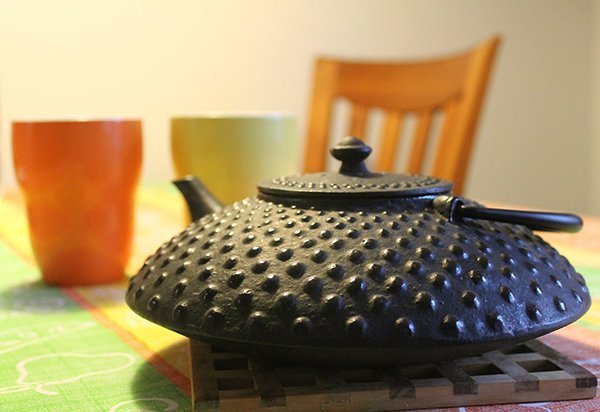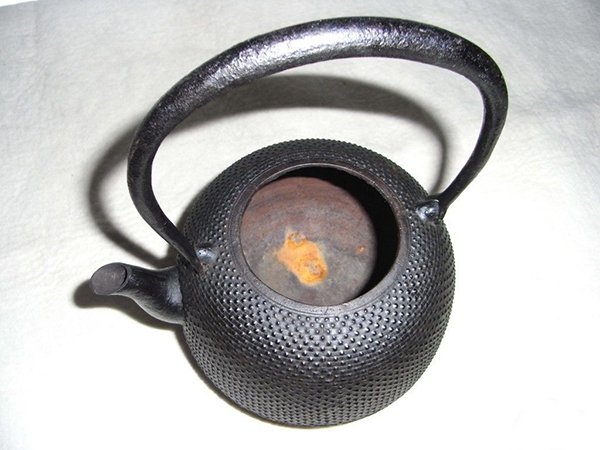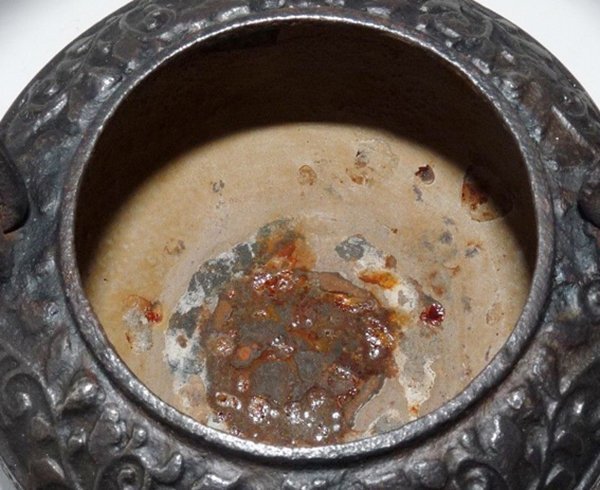Last Updated on 11/28/2020 by Desmond
CONTENT
What Is Cast Iron Teapot
Iron teaware usually refers to a Cast Iron Teapot, or Kettle, used for heating water; some people also use it for cooking tea. Most people thought that water heating by a cast iron teapot would make the taste like a mountain spring. It does a great favor to increase tea infusion quality.
And the look of it is unpretentious, with a Zen feeling. So in China and Japan, where many people embrace Buddhism, the cast iron teapot is popular.
The Chinese Gongfu Tea Ceremony and Japanese Sado have a common point: prefer heating water with a cast iron teapot and a small carbon stove. But about the style and using method, they got a noticeable difference.
About the kettle of the Traditional Gongfu Tea Ceremony in Chaoshan, China, the spout and handle typically design that takes each other at a right angle. And the handle is long and with a wooden wrapped. This style helps brewing become easier. But some modern small Gongfu Kettle is designed similar to the Japanese-style and equipped with a little electric stove.
In the Japanese Sado, the cast-iron teapot is also called Tetsubin. The using way is more complicated and elegant. First, the Sado event will hold in a traditional Japanese tea house. There is a pit furnace set in the place a little off the room center. When getting water, no need to pick the teapot up; just use a special bamboo spoon. Sometimes, people also suspending teapot for heating. Due to the high heat-conducting property, the water will be heat or cool down soon. It is more comfortable for brewing the Macha green tea.
Even though it is made from low-cost iron, but some cast-iron teapots still expensive. They are mainly hand-made by the top master, with ingenious and delicate design, and a high collection value. However, only talk about the use, nothing will be a big difference from the normal one. Some very awesome cast iron teapot on Amazon only cost dozens of dollars.

Cast Iron Teapot Pros
The advantages of cast iron teapot mainly come from its material.
Make Water Sweet
We may ever lick some metal stuff and feel a sweet taste. It’s because of the iron ions. And when heating water, the iron teapot will separate infinitesimal ferrous ions. That will make the water become sweeter and tastes like the mountain spring.
Except for the sweetening, the iron ions also will compact with the tannin in tea(a component that brings the bitter taste to tea) and makes the tea taste not such astringent. But some tea lovers thought it breaks the natural flavor of the low-fermented tea and influences them to judge the quality.
Soften Water
Not everyone can brew tea with mountain spring water anytime, and the water in each region has a different quality. We used to talk about how water’s hardness affects tea quality, and we’ve known the hard water is not suitable for brewing tea.
Heating water with a cast iron teapot can easily make the calcium and magnesium ions in water sedimented easily and soften it. But a price is, after a long time, there will form a layer of scale in the bottom of the kettle.
Possibly Prevent Anemia
It is a viewpoint without any scientific support. The Chinese Regimen thought that iron is the microelement that the human body needs. Firing food with an iron pan can let people far away from anemia, so the same benefit to a cast iron teapot.
In fact, the iron ions it separates are too few. They will compact with the calcium and magnesium in water first, then with the tannin in tea. Less left for the human body to absorb. Of course, many merchants still use this possible benefit for the promotion.
High Performance
Iron got an excellent heat-conducting property, makes it heating the water to boil faster than the ceramic one. And the melting point and hardness also higher, more durable than the copper and silver teapot.

How Cast Iron Teapot Processing
Compare with the uncertain health benefits, more value of cast iron teapot is from the artistic design and processing. Those expensive iron teapots were mostly made from the famous master or some time-honored brand workshop, mainly from Japan. Different processing methods got different characteristics and prices.
Lost-wax Process
The lost-wax process is a very ancient processing method. The masters will make a model with wax, a material with excellent plasticity. Then wrap the clay on it, melt the wax away after the clay dried, to get a mold. Then, fill the molten iron in it, break the mold after the iron cools down, and get a product.
The cast iron teapot made through lost-wax processing got the integrality and uniqueness pros, without splicing traces on its body. And one mold only for one teapot producing, it makes it got a higher collection value. But this method is too complicated and fussy, and less manufacturer took it.
Worthing knowing, nowadays some manufacturers will make the wax mold by 3D printing quickly in bulk, then go on the further processing in the traditional lost-wax method. Even though this kind of iron teapot also got an integrality, but not the only one in the world, so with less collection value.
Sand Casting
Sand casting also a raw processing method. First, make a metal teapot mold, 2 external molds, and 1 internal, then press the shape on 2 sandboards and create an inner sand mold. Combine them together, fill the molten iron in, break the sandboard after the iron cools down, and get a teapot.
The sand casting is a little easier than the lost-wax process, still complicated. Besides, there will be a distinct splicing trace and a filling hole on the final product’s body.
How To Use A Cast Iron Teapot
About the using way, the iron teapot is much like a kettle. It is not suitable for brewing because of the large volume. People usually use it for heating water or cooking tea.
Heat Water
A traditional and more elegant way is to heat water with a cast iron teapot and a small carbon stove. Of course, not everyone has enough time to set a carbon stove, which is also a little dangerous. So an electric ceramic cooker or induction cooker also an awesome choice. Remember never to use a gas cooker; the naked fire will leave some ugly trace on the teapot’s body. But the traces left by carbon fire is nice.
Besides, when heating water, just fill 3/5 water of the teapot, avoid it overflow when boiling. And when you pour the water, wrap a towel on the holder, and take care with the steam.
Cooking Tea
Some tea lovers like to cook tea with a cast iron teapot, but it’s not like the Tibetan Butter Tea making way. They prefer to cook the high-fermented leaves like ripe Pu-erh, rock tea, or aged Tieguanyin. Because these leaves are resistant to brew, and much suitable for long-time cooking to extract the taste.
Some low-fermented tea, like green and yellow tea, is not suitable for cooking. The iron ions will make the infusion color worse, and the water temperature and steeping time are also not right.
How To Maintain A Cast Iron Teapot
It is trouble for many people to maintain a cast iron teapot; a common problem is getting rust. It is different from the copper teapot, which will get better protection by oxidation. Once an iron teapot got rust, it will spread quickly. Not only affects the beautiful appearance, but it even leads to broken.

The cast iron teapot maintenance job must start from rust prevention.
Daily Precautions
- Don’t leave water in the cast iron teapot for a long time. Dry it thoroughly after every time use;
- Don’t try to heat the water to evaporate completely; it will hurt the teapot a lot;
- Avoid letting the teapot in a sudden temperature change. After pouring out all the boiling water, waiting for the teapot to cool down, then refill the water;
- Wiping the cast iron teapot with a soft towel often in peacetime to keep its body dry and clean. If you do that, the surface will get more and more smooth and bright. Remember never to use the hard brush to do the clean job;
Remove The Rust ASAP

We know that iron is very afraid of air and water; they make it rust. The rust is everywhere because we cannot isolate air and water thoroughly. Once the teapot gets rust, it will absorb the moisture in the air faster and spread quickly. So once we found the rust, we must clean them up asap.
Here are some tips for removing the rust on cast iron teapot.
Even though we know the strong acid can help remove rust, it may damage the teapot simultaneously. So it is not the best choice. And some excellent rust remover is also not suitable, because the teapot is a kind of tableware, use rust remover may hurt the human body.
We can use the disadvantages of cast iron teapots. Put 5-8g green tea into the teapot, adding water, and cook for 15-20 mins. The rust will compact with the tannin and become easier to remove. Don’t use the high-fermented leaves like ripe Pu-erh; the dark color infusion may leave some ugly trace on the rust place.
After taking it twice, instead of the leaves with 2-3 pieces of lemon slices, the same cooking for 15-20 mins, twice. Then repeat with water twice. At this time, most internal rust has gone. Finally, wipe up the rest with a soft towel, flushing them away, then dry thoroughly.
To the rust on the outface or some stubborn one, you can take a soft toothbrush(not the electric one) to dip some lemon juice, wipe gently. Notice not to be too hard and scratch the surface.
About The Scale
Except for the rust, there will form some scale inside the cast iron teapot after long-time use. They come from the combination of iron ions and calcium and magnesium ions in water. People have two different views on it.
Some people thought these scales would cover the rust and prevent it from spread effectively. And the cast iron teapot with scales in, the water it boils would tastes smoother. And the other side thought the scales would influence the iron ions’ separates and hurtful to health. I agree with the second view; after all, these scales look ugly. You can remove them up when cleaning up the rust.
